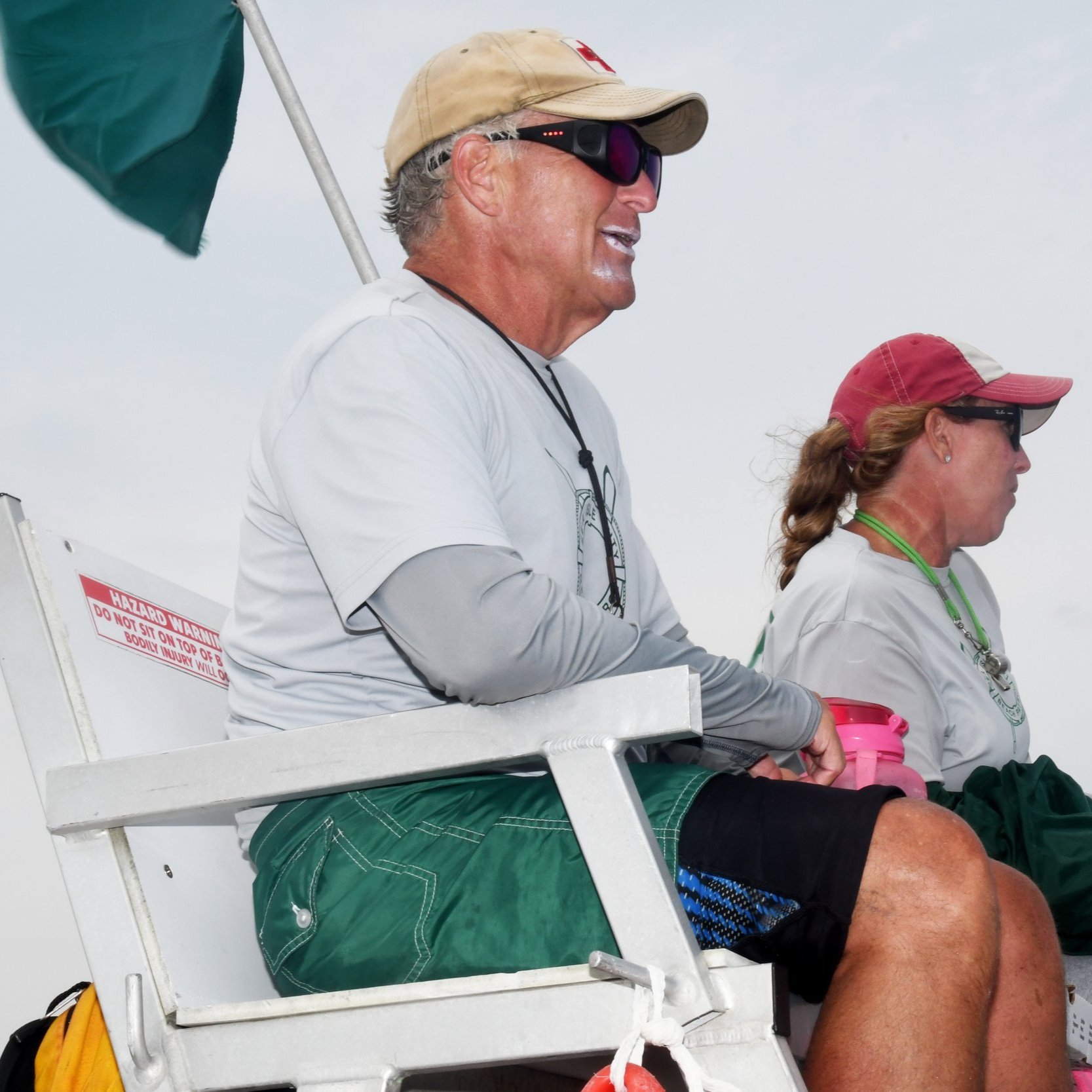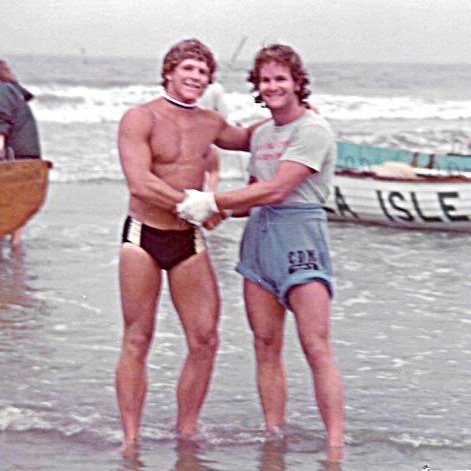The Doctor is in…The Lifeguard Stand: Eric Greensmith Returns to the SIC Beach patrol, 47 Years Later
The good doctor at his post in 2022.
Greensmith in the
43rd Street stand in 1973.
“You can’t go back home to your family, back home to your childhood, back home to romantic love, back home to a young man’s dreams of glory and of fame …” – Thomas Wolfe
This summer, as a returning member of the Sea Isle City Beach Patrol, Eric Greensmith needed to complete a series of physical tasks to become requalified to work as a lifeguard here. These tasks are required of all returning lifeguards. After successfully completing the requalification process, he was assigned a lieutenant with whom he will be working throughout the summer. If this sounds like a routine matter … well, it wasn’t.
Eric Greensmith in the 1972 Town Races.
Lifeguards on the SICBP are paid twice per month. However, this summer Greensmith will be receiving an additional payment: On the third Wednesday of each month, his Social Security check will be directly deposited into his bank account. Greensmith last worked as a lifeguard in the resort in 1975. It has been 47 summers since he last sat on a lifeguard stand. At 67, he returned to “sit the wood” as a lifeguard on the beach.
A native of Glenside, Pa., Greensmith was a member of the SICBP from 1972-75. After leaving Sea Isle in the fall of 1975, his future took him on a long, circuitous, and fulfilling route that eventually led him back to the beach patrol for the summer of 2022.
After leaving the beach that September, Greensmith’s first stop was Penn State, where he eventually matriculated with a bachelor’s degree in biology. As an undergraduate, the focus of his studies was on becoming a physician. It was also at Penn State where he met and fell in love with his wife, Kelly. After graduation, the couple left State College and continued on to the University of Virginia, where Greensmith eventually earned his doctorate in physiology. After receiving his Ph.D., his dream was finally realized when he was accepted to Penn State’s medical school in Hershey. While he was completing his anesthesia residency, the Greensmiths were blessed with their son, Peter. Incidentally, also while training at the Polyclinic Medical Center in Harrisburg, Greensmith was interviewed by CBS for “60 Minutes” for the show’s investigative report on resident working hours, stress, and medical mistakes. The episode aired in the mid-1980s.
Upon completing the requirements to become an anesthesiologist, Greensmith went on active duty with the Navy as part of his scholarship obligation while also fulfilling his call to serve his country. While in the Navy, he and Kelly were blessed with their second child, Claire. As Greensmith worked his way through the officer corps, he eventually achieved the rank of commander. At various times he served as a Navy physician at two fleet hospitals and on the aircraft carriers USS George Washington, USS Dwight D. Eisenhower, and the USS Kitty Hawk.
After six years in the Navy, Greensmith accepted a teaching appointment at the University of Iowa. While teaching at the medical school, he also had the opportunity to practice medicine. One of his major interests was pain management and the use and capabilities of hyperbaric chambers. From there, it was on to a long career in both academic and private-practice medicine. His travels first took him to Wisconsin, and then finally to the Lancaster, Pa., area.
Eric Greensmith during his six-year Navy stint.
Posing with Wayne MacMurray (right) at the 1972 Town Races.
After 35 years as an anesthesiologist and critical-care physician, Greensmith retired in April. As he approached retirement, he recognized that he needed to retire to something, not just from something. Upon reflection, he recalled his lifeguard days as meaningful and fun. That made him wonder if at age 67 if he could meet the physical requirements for requalification and join the patrol once again. We are very happy to report that after almost eight months of strenuous physical training, Greensmith is once again a full-time, fully qualified member of the Sea Isle City Beach Patrol.
SICBP Chief Renny Steele is both excited and very happy to have Greensmith on the patrol. When first approached by Greensmith about returning to the beach patrol, Steele was concerned about his ability to meet the strenuous requirements to become certified as an ocean lifeguard. After completing his intense personal training, Greensmith not only met but easily passed all of the required physical tests. This was completed alongside – and to the amazement of and full encouragement of – all the younger returning lifeguards.
Steele remembers Greensmith well from his first stint on the beach patrol in the early to mid-1970s. While working as a lifeguard, Steele and Gary McMillan shared a lifeguard stand with Greensmith and served as his senior guards, helping to train the novice lifeguard in the ways of the ocean. “Eric was an excellent lifeguard,” Steele recalls. Now, Steele notes, Greensmith “offers the community value beyond his lifeguarding skills. The fact that he is a physician is an added bonus.”
The SICBP employs 13 emergency medical technicians and has a nurse on staff. Steele says, “Adding a physician to that mix can only improve the Beach Patrol’s training and professionalism when responding to medical emergencies.”
Greensmith notes that lifeguarding has similarities to the practice of anesthesiology.
“Both require extensive preparation, attention to detail, and unwavering vigilance,” he says. “Both are fully committed to the safety of others. In both jobs, it takes a lot of work to make sure that nothing exciting happens.”
Dr. Greensmith, chief anesthesiologist at Lancaster Regional Medical Center, pauses to discuss a case with nurse Linda Hershey in 2013. Photo: Baltimore Sun
With his many life experiences, Greensmith has brought a unique set of skills to the lifeguard stand. As a physician and a lifeguard, he knows that unforeseen circumstances can easily arise in the operating room or on the beach. Seasoned clinicians and lifeguards must “read the water” to anticipate potential hazards and intervene to avoid dangerous situations that could risk bad outcomes. Incidentally, the symbol of the American Society of Anesthesiologists is a lighthouse that “represents ASA’s commitment to physician anesthesiologists around the world to organize and form a union of sharp minds, kind hearts and steady hands to protect patients during their most vulnerable moments.”
Reactions to Greensmith’s career change have ranged from incredulity to admiration. Due to shifting demographics and a pause in guard training during the pandemic, the American Lifeguard Association has indicated that this summer in general and late August in particular might pose a national lifeguard shortfall. This shortage is already being felt by local beach patrols as well as lakes and pools throughout the nation.
Retirees who meet the qualifications may represent an untapped resource in the lifeguarding sphere. Readers may recall that last summer, retired pharmaceutical consultant Kirk Oates made the SICBP roster as a 58-year-old rookie; he eventually worked a total of 56 days on the beach. He is back again this year.
Greensmith clearly enjoying his return to beach duty.
Greensmith’s journey back to the SICBP could not have been completed without the full encouragement of his family. The support from his wife Kelly has been unwavering, while his two children have at times run and swam alongside of him, encouraging him as he trained. Peter, 31, now is a pharmaceutical executive in Massachusetts. Says Claire, 29, who is a nurse at Duke University: “It’s really cool to see my father achieve his goal of making the beach patrol. We are very proud of him, and very happy. We are all amazed at the energy that he put into his training.”
As for the future, Greensmith is uncommitted, preferring to enjoy every day of this summer on the beach. Back in Lancaster, Greensmith is still very much in demand and will continue accepting temporary hospital appointments a few days per month as fall turns into winter. But for now, during the months of July, August, and September, the beach and bathers of Sea Isle City have his full attention.
Dr. J. Eric Greensmith is proving Thomas Wolfe wrong: You can go home again.







